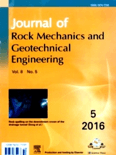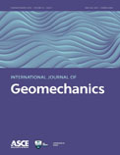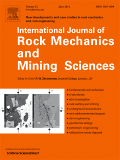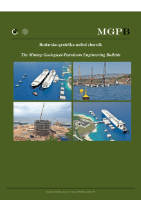
Journal of Rock Mechanics and Geotechnical Engineering
Scope & Guideline
Advancing Geotechnical Frontiers with Insightful Research
Introduction
Aims and Scopes
- Rock Mechanics and Material Behavior:
The journal emphasizes the study of rock behavior under various loading conditions, including stress-strain relationships, fracture mechanics, and failure mechanisms. It covers both experimental and numerical investigations of rock materials. - Geotechnical Engineering Applications:
Research focused on practical geotechnical applications, including foundation design, slope stability, tunneling, and excavation techniques. The journal aims to bridge the gap between theoretical research and field applications. - Hydro-mechanical Coupling:
The journal investigates the interaction between mechanical and hydraulic processes in geotechnical systems, particularly in saturated and unsaturated soils and fractured rock masses. - Innovative Testing and Monitoring Techniques:
Research on new methodologies for testing and monitoring rock and soil behavior, including the use of advanced sensors, machine learning, and numerical modeling techniques. - Environmental and Sustainability Considerations:
The journal addresses the environmental impacts of geotechnical projects, including soil stabilization techniques, waste management, and the use of sustainable materials. - Data-driven Approaches:
The integration of machine learning and data analytics in geotechnical engineering is a growing theme, focusing on predictive modeling and risk assessment.
Trending and Emerging
- Machine Learning and AI Applications:
An increasing number of papers are focusing on the application of machine learning and artificial intelligence techniques to predict rock behavior, optimize geotechnical designs, and enhance data analysis. - Sustainable and Eco-friendly Engineering Practices:
Research on sustainable practices in geotechnical engineering, including the use of bio-based materials and techniques for soil stabilization, is gaining traction as environmental considerations become more critical. - Advanced Monitoring and Sensing Technologies:
The use of advanced monitoring technologies, such as fiber optic sensing and other real-time data acquisition techniques, is trending, reflecting the need for precise monitoring of geotechnical structures. - Hydraulic Fracturing and CO2 Sequestration:
There is a growing interest in the study of hydraulic fracturing and the implications of CO2 sequestration, particularly in relation to geomechanics and environmental impacts. - Multi-physical Modeling Approaches:
Research incorporating multi-physical modeling that combines mechanical, hydraulic, and thermal effects in geotechnical contexts is on the rise, indicating a trend towards more comprehensive modeling frameworks.
Declining or Waning
- Traditional Analytical Methods:
There is a noticeable decrease in research employing conventional analytical methods for rock mechanics, as more researchers are adopting computational and data-driven techniques. - Basic Laboratory Testing Techniques:
The publication of studies solely focused on basic laboratory testing without integrating advanced methodologies or technologies is becoming less frequent, indicating a shift towards more innovative and comprehensive approaches. - Static Analysis in Isolation:
Research focusing on static analysis of rock behavior in isolation, without considering dynamic or environmental factors, is declining in favor of more holistic approaches that consider real-world complexities. - Generalized Theoretical Models:
There has been a decrease in the development of generalized theoretical models that do not cater to specific case studies or applications, as the field moves towards more tailored and application-based research.
Similar Journals

COMPUTERS AND GEOTECHNICS
Empowering Geotechnical Solutions through Cutting-edge Technology.COMPUTERS AND GEOTECHNICS is a premier scholarly journal published by Elsevier Science Ltd, devoted to advancing the intersection of computer science and geotechnical engineering. With an impressive impact factor and categorically recognized as a Q1 journal in both Computer Science Applications and Geotechnical Engineering as of 2023, it stands at the forefront of research in its field. The journal has maintained a remarkable reputation since its inception in 1985, providing a dynamic platform for disseminating cutting-edge research, technological advancements, and innovative methodologies related to the application of computer science in geotechnics. Researchers, professionals, and students benefit from its rigorous peer-review process and high-quality publications, which demonstrate practical applications and theoretical foundations necessary for the relevant industries. Renowned for an extensive global readership, COMPUTERS AND GEOTECHNICS plays a critical role in fostering collaboration and development in tackling complex geotechnical challenges through computational methods, all while contributing to the broader understanding of environmental interactions. This journal provides essential insights and is instrumental for those at the cutting edge of this evolving discipline.

International Journal of Geomechanics
Unveiling the complexities of earth structures and soil behavior.The International Journal of Geomechanics, proudly published by the American Society of Civil Engineers (ASCE), stands as a pivotal cornerstone in the fields of geotechnical engineering, engineering geology, and soil science. With an esteemed Q1 ranking in both geotechnical engineering and soil science as of 2023, it represents a high-impact platform (impact factor information to be inferred as impressive given the rankings and prominence in the field). Since its inception in 2001, this journal has been committed to advancing the understanding of geomechanical processes, offering a vital forum for researchers, professionals, and students to disseminate innovative findings and practical applications. The journal is indexed by Scopus, holding an impressive position at rank #48 out of 229 in its disciplines, illustrating its significance and influence in the academic community. Although it does not currently offer open access, the journal continues to attract a diverse readership with its critical insights into soil behavior, earth structures, and various geotechnical challenges. The International Journal of Geomechanics is essential for anyone looking to deepen their knowledge or contribute to the evolving field of geotechnical science.

INTERNATIONAL JOURNAL OF ROCK MECHANICS AND MINING SCIENCES
Exploring Innovative Solutions for Rock Mechanics Challenges.Welcome to the INTERNATIONAL JOURNAL OF ROCK MECHANICS AND MINING SCIENCES, an esteemed publication in the field of geotechnical engineering and engineering geology, published by PERGAMON-ELSEVIER SCIENCE LTD. With a commendable ISSN of 1365-1609 and an E-ISSN of 1873-4545, this journal stands as a critical resource for advancing scientific understanding within the disciplines associated with rock mechanics and the mining industry. Holding a prestigious Q1 category ranking in the 2023 metrics, the journal is positioned in the top tier of its field, demonstrating its impact in the research community, with a Scopus rank of 2 out of 229 and a remarkable 99th percentile recognition. Established in 1969, the journal aims to facilitate the exchange of high-quality research, encompassing innovative methodologies, practical applications, and theoretical advancements relevant to both academia and industry. While the journal does not currently offer open access, its extensive backlist and current issues are accessible through various academic databases, ensuring that vital knowledge is shared with a broad audience. The INTERNATIONAL JOURNAL OF ROCK MECHANICS AND MINING SCIENCES is not only a key platform for researchers and professionals but also a valuable educational resource for students aspiring to delve into the complexities of rock mechanics and mining practices.

Geotechnical and Geological Engineering
Exploring the Intersection of Geology and Engineering ExcellenceGeotechnical and Geological Engineering, published by SPRINGER, is a premier journal dedicated to advancing the field of geotechnical and geological engineering. With a strong reputation demonstrated by a robust impact factor and notable Scopus rankings, the journal positions itself in the top quartile of categories such as Architecture and Geotechnical Engineering, making it an essential resource for researchers and practitioners alike. Established in 1991 and continuing through 2024, it provides a platform for original research that addresses the pivotal challenges in soil science, geology, and engineering geology. Although it does not offer open access, it remains accessible through institutional and personal subscriptions, ensuring that academic scholars, industry professionals, and students can engage with high-quality, peer-reviewed content. The journal's commitment to disseminating innovative findings and fostering interdisciplinary dialogue underscores its vital role in shaping future developments in engineering and environmental sustainability.

PROCEEDINGS OF THE INSTITUTION OF CIVIL ENGINEERS-GEOTECHNICAL ENGINEERING
Advancing Geotechnical Knowledge for Tomorrow's InfrastructurePROCEEDINGS OF THE INSTITUTION OF CIVIL ENGINEERS-GEOTECHNICAL ENGINEERING, published by Emerald Group Publishing Ltd, is a prestigious journal that serves the dynamic field of geotechnical engineering and broader earth sciences. With an ISSN of 1353-2618 and an E-ISSN of 1751-8563, this journal has established itself as a vital resource for researchers, professionals, and students alike, offering insights into innovative practices and developments within the geotechnical domain. It ranks within the Q2 category for Earth and Planetary Sciences and Geotechnical Engineering as of 2023, demonstrating its significant impact and relevance in these fields. Given its comprehensive scope from 1994 to 2024, the journal provides a platform for high-quality research articles, case studies, and technical notes, although it presently does not offer open access options. Researchers seeking to publish their work will find this journal an essential venue for reaching an audience deeply invested in the advancement of geotechnical methodologies and solutions.

Soil Mechanics and Foundation Engineering
Advancing the Foundations of Engineering KnowledgeSoil Mechanics and Foundation Engineering, published by SPRINGER, is a prestigious academic journal dedicated to the dynamic fields of soil mechanics and foundation engineering. With a history spanning from 1964 to 2024, this journal serves as a vital platform for researchers, professionals, and students looking to advance their knowledge and explore innovative techniques in soil behavior, foundation design, and geotechnical engineering. Although the journal does not currently operate under an open access model, it remains essential for its contributions to key disciplines, notably in energy, geotechnical engineering, ocean engineering, soil science, and water science. Positioning itself in the third quartile of various categories in the 2023 rankings, it reflects a commitment to maintaining rigorous research standards despite its competitive environment. The unique intersection of its scope allows for multidisciplinary collaboration, making it an invaluable resource for those aiming to tackle the challenges in foundation systems and soil interactions in diverse engineering applications.

Bulletin of Engineering Geology and the Environment
Exploring the intersections of geology and engineering innovation.Bulletin of Engineering Geology and the Environment, published by SPRINGER HEIDELBERG, is a leading journal dedicated to the fields of Geology, Geotechnical Engineering, and Engineering Geology. With an impressive impact factor placing it in the Q1 category for both geology and geotechnical disciplines, this journal is recognized for its significant contributions to the knowledge and application of engineering geology practices. Since its inception in 1984, the Bulletin has provided a platform for researchers and professionals to share cutting-edge research, case studies, and innovative methodologies relevant to the challenges of understanding and managing geological environments. With a robust Scopus ranking—#32/321 in Geology and #43/229 in Geotechnical Engineering—this journal is an essential resource for academics and industry leaders alike, striving to advance the environmental engineering field. For those interested in accessing the latest research and developments, the Bulletin fosters a collaborative and informed scholarly community.

Rock and Soil Mechanics
Bridging Theory and Practice in Soil ScienceRock and Soil Mechanics is a premier academic journal published by SCIENCE PRESS focusing on the critical fields of civil and structural engineering, geotechnical engineering, and soil science. With an ISSN of 1000-7598 and transitioning to an Open Access format since 2020, the journal strives to enhance the accessibility of cutting-edge research to a global audience, making significant contributions to practices and methodologies in these crucial disciplines. Ranked in the Q2 category for Civil and Structural Engineering as well as Geotechnical Engineering and Engineering Geology, and Soil Science, it boasts respectable standings in Scopus rankings, further affirming its relevance and credibility within the scientific community. The journal not only serves as a platform for original research but also engages with the latest advances in technology and innovative applications in rock and soil mechanics, proving invaluable for researchers, practitioners, and students alike as they navigate an increasingly complex field of study.

Rudarsko-Geolosko-Naftni Zbornik
Pioneering Research in Natural Resource ManagementRudarsko-Geolosko-Naftni Zbornik, the esteemed journal published by the University of Zagreb's Faculty of Mining, Geology and Petroleum Engineering, serves as a vital platform for advancing knowledge in the fields of Earth sciences, energy, and geology. With an ISSN of 0353-4529 and an E-ISSN of 1849-0409, this open-access journal has been disseminating high-quality research since 1989, contributing significantly to scientific discourse in Croatia and beyond. As of 2023, it holds an impressive categorization in various quartiles, notably achieving Q2 in Earth and Planetary Sciences and Q3 in several related domains, showcasing its relevance and impact within the academic community. The journal's commitment to quality is reflected in its Scopus rankings, placing it in competitive positions across diverse disciplines. Researchers, professionals, and students alike will find invaluable resources and insights that foster innovation and collaboration in their respective fields, making Rudarsko-Geolosko-Naftni Zbornik an essential read for those dedicated to exploring the complexities of natural resources and environmental challenges.

CANADIAN GEOTECHNICAL JOURNAL
Advancing Geotechnical Knowledge for a Sustainable FutureCanadian Geotechnical Journal, published by Canadian Science Publishing, stands as a premier resource in the field of geotechnical engineering, focusing on the science and practice of soil mechanics, engineering geology, and related disciplines. Established in 1968, this esteemed journal has earned a distinguished reputation, holding a Q1 ranking in both Civil and Structural Engineering as well as Geotechnical Engineering and Engineering Geology as of 2023. It features a rigorous peer-review process that ensures the publication of high-quality research, making it essential reading for researchers, professionals, and students alike. With an impressive Scopus rank of #63 out of 379 in Civil and Structural Engineering and #41 out of 229 in Geotechnical Engineering, the journal continues to contribute significantly to the advancement of knowledge in geotechnics. While the journal does not currently provide open access options, it remains a vital platform for disseminating innovative findings and fostering academic collaboration in the geotechnical community.